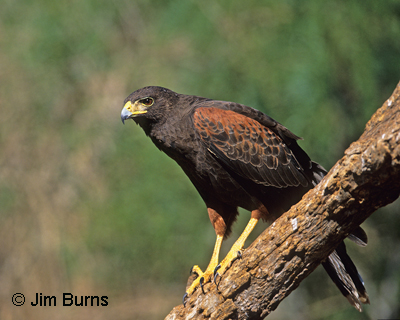
This is beautiful chocolate brown hawk with chestnut shoulder patches, leggings, and wing linings. The best identifying feature on both perched and flying Harris's is the white rump (base of the tail) patch. This species was named by John James Audubon, the nineteenth century bird painter, for his wealthy friend and benefactor, Edward Harris.
Arizona's Harris's hawks exhibit three extraordinary behavioral traits uncharacteristic of other raptors: they engage in social or communal nesting; they hunt cooperatively; and in wet weather cycles when prey is abundant they breed year round.
Aunts, uncles, and immatures from previous broods help the "alpha female" by defending the nest and bringing prey to the nestlings. These family groups, sometimes numbering as many as seven adult birds, remain together, "team hunting," throughout the year. Three well documented strategies are used. One, known as surprise pounce, occurs when several hawks converge from different directions on a mammal which has been caught in the open. Flush and ambush, used primarily on cottontails and quail, involves one hawk penetrating thick brush while cohorts wait nearby for anything which spooks from the cover. A third strategy is the relay attack in which multiple hawks run their prey to exhaustion.
Harris's hawk nests are large, sprawling stick platforms usually built in the crotch of a tall cottonwood or large, armed saguaro. The nesting season in a typical year is February through June. For many years the surest place to observe Harris's hawks in Phoenix has been Papago Park where they nest in the big cottonwoods inside the Phoenix Zoo. Families are regularly seen in McDowell Mountain Park, in the open desert areas of north Scottsdale and Carefree, and along the Verde River east of Phoenix.
This raptor seems to be adapting well to urban living and its numbers are increasing, though this good news is mitigated by many incidents of electrocution on power lines and promiscuous takings by falconry enthusiasts who prize this species for its tolerant personality, its maneuverability in flight, and its lightning acceleration after ground prey.
A good, working definition for "raptor" is a bird of prey that has talons and/or a hooked beak for tearing meat. A little scary perhaps, but jackrabbits are the Harris's hawk's largest prey, so get the kids out there to look for this beautiful, urbanized hawk whose unique hunting style will teach them how things work in the natural world.